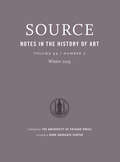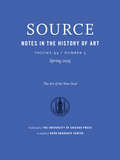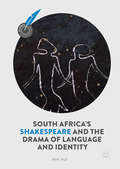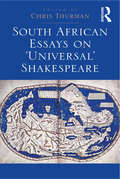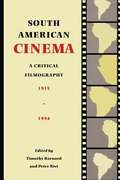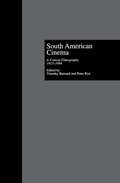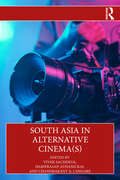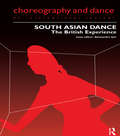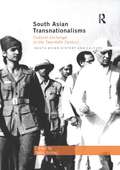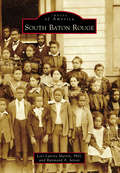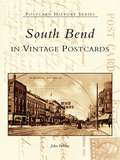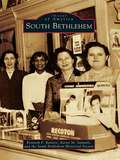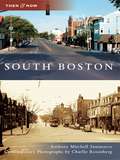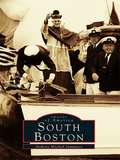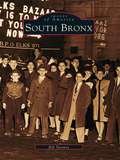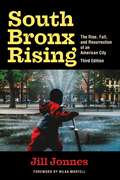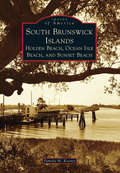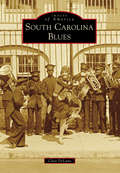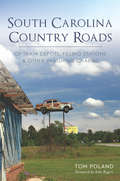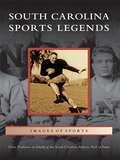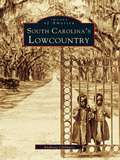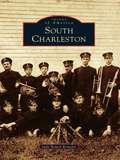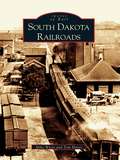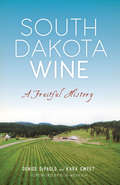- Table View
- List View
Source: Notes in the History of Art, volume 44 number 2 (Winter 2025)
by Source: Notes in the History of ArtThis is volume 44 issue 2 of Source: Notes in the History of Art. Source was founded in 1981 as a scholarly journal in art history. Its mission is to publish articles of 2,500 words or less, accompanied by a maximum of three illustrations. The range of articles spans antiquity to the present and includes western and non-western art. The original premise has been borne out: there is an audience for scholarly articles in art history that are clearly written, adequately illustrated and above all, succinct. Furthermore, scholars welcome having a forum to present ideas and speculations that don’t warrant a major treatise, but might nevertheless make interesting “notes” for specialists and non-specialists alike.
Source: Notes in the History of Art, volume 44 number 3 (Spring 2025)
by Source: Notes in the History of ArtThis is volume 44 issue 3 of Source: Notes in the History of Art. Source was founded in 1981 as a scholarly journal in art history. Its mission is to publish articles of 2,500 words or less, accompanied by a maximum of three illustrations. The range of articles spans antiquity to the present and includes western and non-western art. The original premise has been borne out: there is an audience for scholarly articles in art history that are clearly written, adequately illustrated and above all, succinct. Furthermore, scholars welcome having a forum to present ideas and speculations that don’t warrant a major treatise, but might nevertheless make interesting “notes” for specialists and non-specialists alike.
South Africa's Shakespeare and the Drama of Language and Identity (Global Shakespeares)
by Adele SeeffThis volume considers the linguistic complexities associated with Shakespeare’s presence in South Africa from 1801 to early twentieth-first century televisual updatings of the texts as a means of exploring individual and collective forms of identity. A case study approach demonstrates how Shakespeare’s texts are available for ideologically driven linguistic programs. Seeff introduces the African Theatre, Cape Town, in 1801, multilingual site of the first recorded performance of a Shakespeare play in Southern Africa where rival, amateur theatrical groups performed in turn, in English, Dutch, German, and French. Chapter 3 offers three vectors of a broadening Shakespeare diaspora in English, Afrikaans, and Setswana in the second half of the nineteenth century. Chapter 4 analyses André Brink’s Kinkels innie Kabel, a transposition of Shakespeare’s The Comedy of Errors into Kaaps, as a radical critique of apartheid’s obsession with linguistic and ethnic purity. Chapter 5 investigates John Kani’s performance of Othello as a Xhosa warrior chief with access to the ancient tradition of Xhosa storytellers. Shakespeare in Mzansi, a televisual miniseries uses black actors, vernacular languages, and local settings to Africanize Macbeth and reclaim a cross-cultural, multilingualism. An Afterword assesses the future of Shakespeare in a post-rainbow, decolonizing South Africa. Global Sha Any reader interested in Shakespeare Studies, global Shakespeare, Shakespeare in performance, Shakespeare and appropriation, Shakespeare and language, Literacy Studies, race, and South African cultural history will be drawn to this book.
South African Essays on 'Universal' Shakespeare
by Chris ThurmanSouth African Essays on ’Universal’ Shakespeare collects new scholarship and extant (but previously unpublished) material, reflecting the changing nature of Shakespeare studies across various ’generation gaps’. Each essay, in exploring the nuances of Shakespearean production and reception across time and space, is inflected by a South African connection. In some cases, this is simply because of the author’s nationality or institutional affiliation; in others, there is a direct engagement with what Shakespeare means, or has meant, in South Africa. By investigating the universality of Shakespeare from both implicitly and explicitly ’southern’ perspectives, the book presents new possibilities for considering (and reassessing) shifting manifestations of Shakespeare’s work in major Shakespearean ’centres’ such as Britain and the United States, as well as across the global North and South.
South African National Cinema (National Cinemas)
by Jacqueline MaingardSouth African National Cinema examines how cinema in South Africa represents national identities, particularly with regard to race. This significant and unique contribution establishes interrelationships between South African cinema and key points in South Africa’s history, showing how cinema figures in the making, entrenching and undoing of apartheid. This study spans the twentieth century and beyond through detailed analyses of selected films, beginning with De Voortrekkers (1916) through to Mapantsula (1988) and films produced post apartheid, including Drum (2004), Tsotsi (2005) and Zulu Love Letter (2004). Jacqueline Maingard discusses how cinema reproduced and constructed a white national identity, taking readers through cinema’s role in building white Afrikaner nationalism in the 1930s and 1940s. She then moves to examine film culture and modernity in the development of black audiences from the 1920s to the 1950s, especially in a group of films that includes Jim Comes to Joburg (1949) and Come Back, Africa (1959). Jacqueline Maingard also considers the effects of the apartheid state’s film subsidy system in the 1960s and 1970s and focuses on cinema against apartheid in the 1980s. She reflects upon shifting national cinema policies following the first democratic election in 1994 and how it became possible for the first time to imagine an inclusive national film culture. Illustrated throughout with excellent visual examples, this cinema history will be of value to film scholars and historians, as well as to practitioners in South Africa today.
South American Cinema: A Critical Filmography 1915-1994
by Timothy Barnard Peter RistOriginally issued in hardcover in 1996 by Garland Publishing, this important reference work is now available in paperback for a wider audience. A distinguished team of contributors has compiled entries on 140 significant South American feature films from the silent era until 1994. The entries discuss each film's subject matter, critical reception, and social and political contexts, as well as its production, distribution, and exhibition history, including technical credits. The entries are grouped by country and arranged chronologically. Both fiction and documentary films (some no longer in existence) are included, as well as extensive title, name, and subject indexes and glossaries of film and foreign terms.
South American Cinema: A Critical Filmography, l915-l994 (Historical Dictionaries Of Literature And The Arts Ser.)
by Timothy Barnard Peter RistFirst Published in 1996. This text looks at the cinema from the countries of Argentina, Brazil, Canada, Chile, Colombia, Cuba, United States, Uruguay and Venezuela. Presented by country and date order it includes the silent black and white Gaucho films of 1915 to the colour films coming out of Venezuela in 1991. Each entry provides a summary of the film content, its context, production and significance in the genre. It includes an index and glossary of Brazilian (Portuguese or African) Terms and film terms.
South Asia in Alternative Cinema(s)
by Vivek Sachdeva Hariprasad Athanickal Chandrakant A. LangareSouth Asia in Alternative Cinema(s) explores the significance and relevance of parallel, the new wave, the new middle cinema, avant-garde and independent cinemas from and on India, Pakistan, Bhutan, Sri Lanka, Bangladesh and other parts of South Asia. The scholarly and groundbreaking articles interrogate, in a global context, intersecting social, political and cultural issues and offer a rich discourse on the works of eminent filmmakers and their cinematic compositions. The original articles focus on the “New Wave” in Hindi, Kannada, Bengali, Malayalam, Assamese and other regional languages of India, as well as experimental/independent films from and on India, Pakistan, Bhutan, Bangladesh, Sri Lanka and other parts of South Asia, irrespective of the language in which they are made.The book also offers new insights and a fresh perspective on the contentious intellectual relation between human life and its reflection in cinemas.
South Asian Dance: The British Experience
by Alessandra IyerFirst Published in 1998. Routledge is an imprint of Taylor & Francis, an informa company.
South Asian Transnationalisms: Cultural Exchange in the Twentieth Century (Routledge South Asian History and Culture Series)
by Babli SinhaSouth Asian Transnationalisms explores encounters in twentieth century South Asia beyond the conventional categories of center and periphery, colonizer and colonized. Considering the cultural and political exchanges between artists and intellectuals of South Asia with counterparts in the United States, continental Europe, the Caribbean, and East Asia, the contributors interrogate the relationships between identity and agency, language and space, race and empire, nation and ethnicity, and diaspora and nationality. This book deploys transnational syntaxes such as cinema, dance, and literature to reflect on social, technological, and political change. Conceiving of the transnational as neither liberatory nor necessarily hegemonic, the authors seek to explore the contradictions, opportunities, disjunctures, and exclusions of the vexed experience of globalization in South Asia. This book was published as a special issue of South Asian History and Culture.
South Baton Rouge (Images of America)
by Lori Latrice Martin Raymond A. JetsonFounded in 1699, Baton Rouge was the site of countless historic events and the home to many people, including those of African ancestry. South Baton Rouge is an African American community located in Baton Rouge. It was one of the first places African Americans could receive a high school education in the state. The three-mile community around historic McKinley High School was the site of the nation's first successful bus boycott. When laws restricted where African Americans could live, work, learn, and play, South Baton Rouge was a refuge. African American restaurants, theaters, gas stations, and other businesses populated the community, and change-makers, including African American lawyers, judges, clergy, educators, and nurses, helped to sustain the community and other portions of the southern half of Louisiana's capital through the end of legal segregation and beyond.
South Bend in Vintage Postcards (Postcard History)
by John PalmerIn the early 20th century, South Bend, Indiana's population more than tripled. Established industries like Studebaker and the Singer Sewing company rose to unprecedented heights of production, new businesses took root, andimmigrants flooded into the area. Photo postcards, originally a quick and inexpensive form of communication, became key documents of South Bend's growth, recording events,businesses, landmarks, and people. Through nearly 200 vintage postcards, this book details South Bend's story from the turn of the 20th century to the aftermath of World War II. These images give a glimpse of lost glamour, representing the city as past generations witnessed it.
South Bethlehem
by Karen M. Samuels Kenneth F. Raniere South Bethlehem Historical SocietyThe story begins in 1848, when the Moravian Brethren sold 274 acres of farmland to investors who resold them as building lots. By 1855, Asa Packer had laid the tracks of his Lehigh Valley Railroad along the Lehigh River, bringing coal from Carbon County to markets in New York and Philadelphia. Industries rapidly grew, with the Pennsylvania and Lehigh Zinc Company in 1853 and the Saucona Iron Company in 1857. By 1865, South Bethlehem became a borough. Charles M. Schwab headed the former Iron Company in 1906, renaming it the Bethlehem Steel Corporation, and was instrumental in uniting the Bethlehems as one city in 1918. Countless immigrants shaped the tone of this region. Today the Sands Casino occupies part of the former Bethlehem Steel site. It is the future home of art and music venues that will contribute to a city already known for its historic and cultural heritage.?
South Boston
by Anthony Mitchell Sammarco Charlie RosenbergSouth Boston, once a part of Dorchester, was annexed to the city of Boston in 1804. Previously known as a tight-knit community of Polish, Lithuanian, and Irish Americans, South Boston has seen tremendous growth and unprecedented change in the last decade.
South Boston (Images of America)
by Anthony Mitchell SammarcoSouth Boston, a peninsular extension of the Massachusetts mainland, was originally dubbed "Great Neck" by the Puritans who settled Dorchester in 1630. After the year 1804, when the town of South Boston was officially separated from Dorchester, tremendous urban development was begun according to a highly organized grid plan. Anthony Mitchell Sammarco's South Boston chronicles the development of this culturally and economically rich suburb from the nineteenth to early twentieth centuries. Southie, as South Boston has affectionately come to be called, today thrives as a close-knit community with a decidedly Irish flavor. Its residents cherish the town's panoramic ocean views along Marine Park, City Point, and Castle Island, and they will delight in exploring Mr. Sammarco's fantastic selection of historic vistas. The community of South Boston is a justifiably proud one whose natural beauty and vitality are elegantly revealed in this well-informed and comprehensive photographic history.
South Bronx (Images of America)
by Bill TwomeyOnce a part of Westchester County, the Bronx was annexed to New York City in the nineteenth century. The South Bronx came to be defined as the area in the southwest part of the borough between the Harlem River and the Bronx River, with Fordham Road generally considered as the northern boundary. Less urban than nearby neighborhoods in Manhattan, the South Bronx attracted countless numbers of immigrants arriving in New York City in the nineteenth and early twentieth centuries. Choosing to raise their families in what was then a country setting, they helped to make the South Bronx one of the most culturally diverse sections of New York. Churches, schools, ballparks, and streets of the old neighborhoods come back to life on the pages of South Bronx. This book revisits the Third Avenue trolley, Old West Farms, the Third Avenue El, tar beach, and the cobblestone roadways of a bygone era. The breweries and old-time taverns that were once such a vital part of the culture of the South Bronx are found anew in these pages. The Schnorer Club, the Elks Club on the Concourse, the Concourse Plaza Hotel, and Yankee Stadium come to life in this stunning collection of more than two hundred images.
South Bronx Rising: The Rise, Fall, and Resurrection of an American City
by Jill JonnesThirty-five years after this landmark of urban history first captured the rise, fall, and rebirth of a once-thriving New York City borough—ravaged in the 1970s and ’80s by disinvestment and fires, then heroically revived and rebuilt in the 1990s by community activists—Jill Jonnes returns to chronicle the ongoing revival of the South Bronx. Though now globally renowned as the birthplace of hip-hop, the South Bronx remains America’s poorest urban congressional district. In this new edition, we meet the present generation of activists who are transforming their communities with the arts and greening, notably the restoration of the Bronx River. For better or worse, real estate investors have noticed, setting off new gentrification struggles.
South Brunswick Islands: Holden Beach, Ocean Isle Beach, and Sunset Beach
by Pamela M. KoontzThe South Brunswick Islands--Holden Beach, Ocean Isle Beach, and Sunset Beach--are man-made barrier islands formed when the North Carolina section of the Intracoastal Waterway was constructed between 1930 and 1940. In the late 1940s, Odell Williamson dreamed of a tranquil, family-vacation island and began buying tracts of land that would later become Ocean Isle Beach. This seven-mile-long island was incorporated as the town of Ocean Isle Beach in 1959. Mannon C. Gore envisioned the three miles of Sunset Beach as a peaceful residential community when he purchased the island in 1955. With over eight miles of oceanfront, Holden Beach is the longest and the largest of the three islands in the group. Each island boasts a unique character and has remained quiet with pristine beaches and a focus on families.
South Carolina Blues
by Clair DeluneThe history of South Carolina blues is a long, deep--and sometimes painful--story. However, it is a narrative with aspects as compelling as the music itself. Geographical differences in America led to variations in the styles of music that developed from African rhythms. The wet, marshy landscape and hot, muggy weather of the Carolina Lowcountry combined to cultivate not only rice, but a Gullah-based style of South Carolina blues. In drier climates, toward the Midlands and the Upstate, the combination of European influences led to the emergence of Piedmont blues, which in turn spawned country music as well as bluegrass. Those same Gullah roots resulted in four major dance crazes, starting with the Charleston.
South Carolina Country Roads: Of Train Depots, Filling Stations & Other Vanishing Charms
by Tom Poland Aïda RogersVenture off the beaten path to forgotten roads, where a hidden South Carolina exists. Time-travel and dead-end at a ferry that leads to wild islands. Cross a rusting steel truss bridge into a scene from the 1930s. Behold an old gristmill and imagine its creaking, clashing gears grinding corn. See an old gas pump wreathed in honeysuckle. Drive through a ghost town and wonder why it died. When's the last time you saw a country store's cured hams hanging from wires? How about a vintage Bull Durham tobacco ad on old brick? Tom Poland explores scenic back roads that lead to heirloom tomatoes, poke salad, restaurants once gas stations, overgrown ruins and other soulful relics.
South Carolina Sports Legends (Images of Sports)
by South Carolina Athletic Hall of Fame Ernie TrubianoSouth Carolina Sports Legends celebrates the golden anniversary of the South Carolina Athletic Hall of Fame. Legendary figures include football luminaries Banks McFadden, Doc Blanchard, "Deacon" Jones, Steve Wadiak, and George Rogers; basketball hotshots Frank Selvy, John Roche, and Alex English; baseball stars Shoeless Joe Jackson, and Bobby Richardson; coaching giants John Heisman, Frank McGuire, Frank Howard, Danny Ford, and John McKissisck; NASCAR legends David Pearson and Cale Yarborough; boxing champion "Smokin' Joe" Frazier; golfer Beth Daniel; Thoroughbred trainer Frank Whiteley; contributors Herman Helms and Bob Fulton; and barrier-breakers Althea Gibson, Lucille Godbold, and Willie Jeffries.
South Carolina's Lowcountry
by Anthony ChibbaroKnown for its unique beauty and complex history, South Carolina's Lowcountry is one of the South's, and the country's, most fascinating regions. A wonderful blend of picturesque coastlines, expansive marshes, mysterious swamps, and verdant landscapes, the Lowcountry has played a vital role in our nation's history, from its importance as a port in colonial times, to its strategic location during the American Revolution, to its most famous landmark, Fort Sumter--the incendiary starting point of the Confederacy's struggle for secession. In this volume, you will explore this region as never before, through a rare collection of stereoscopic images. Also called stereoviews, these twin images were made by an early photographic technique which allowed the viewer to experience a vibrant and intriguing three-dimensional effect. South Carolina's Lowcountry has reproduced one side of each stereoscopic pair in order to facilitate an easier reading and viewing experience, which will allow you to take a visual journey through the defenses of Forts Sumter and Moultrie; to see both Confederate and Union soldiers posing in their camps, by cannon, and upon ironclads; to walk through the rubble of a war-torn Charleston and then observe the dramatic changes of the cityscapes in both the Holy City and Beaufort by the turn of the century; to stroll down a plantation's traditional avenue of live oaks under the peaceful sway of Spanish moss; and to meet a variety of Lowcountry inhabitants at their homes and at work.
South Charleston (Images of America)
by Judy Bowen RomanoSouth Charleston was named for its location on the south bank of the Kanawha River near Charleston. Kanawha Land Company formed the city by combining three farms and securing titles to approximately 2,000 acres in 1906. The area, consisting of hill and bottom land, was used to establish an industrial town. Free land and cheap fuel were offered to plants to locate in South Charleston. By 1907, the town site had been surveyed, and stone from the South Charleston Crusher Company's quarry at Spring Hill was used to pave the sidewalks and some streets. Banner and Dunkirk Glass companies were the town's first businesses, followed by the Ordnance Center and chemical companies.
South Dakota Railroads
by Tom Hayes Mike WieseThe arrival of the railroad in South Dakota is directly responsible for the population boom and town development the state experienced in the early 1900s. Enticed by the promise of opportunity, many immigrants and East Coast residents hopped on the train and headed west, many settling in South Dakota. Railroads opened the doorway and made the West what it has become. Using over 200 images, authors Mike Wiese and Tom Hayes take the reader on a historic tour of the depots, trains, and wrecks that defined South Dakota railroading in the early part of the 20th century. Drawing on their immense collections of images and postcards, they tell a story of railroad development and local history in South Dakota.
South Dakota Wine: A Fruitful History (American Palate)
by Bob Weyrich Denise Depaolo Kara SweetA young commercial wine industry notwithstanding, winemaking traditions run deep in the Mount Rushmore State. Sodbusting pioneers like Anna Pesä and Jon Vojta defied South Dakota’s harsh terrain and paved the way for Prairie Berry Winery. University biologists, including Dr. Ronald Peterson, cultivated the unique grapes needed for the climate, like the Valiant, Marquette, Brianna and Frontenac grapes. Despite subzero winters and torrid summers, strawberries, buffaloberries and rhubarb have grown on both sides of the Missouri River. Since the 1996 Farm Winery Bill passed, the state welcomed thirty vintners, including Strawbale Winery, Wilde Prairie Winery and Belle Joli’ Winery. Denise DePaolo and Kara Sweet explore the heritage behind winemaking from the harvests of the prairie.
